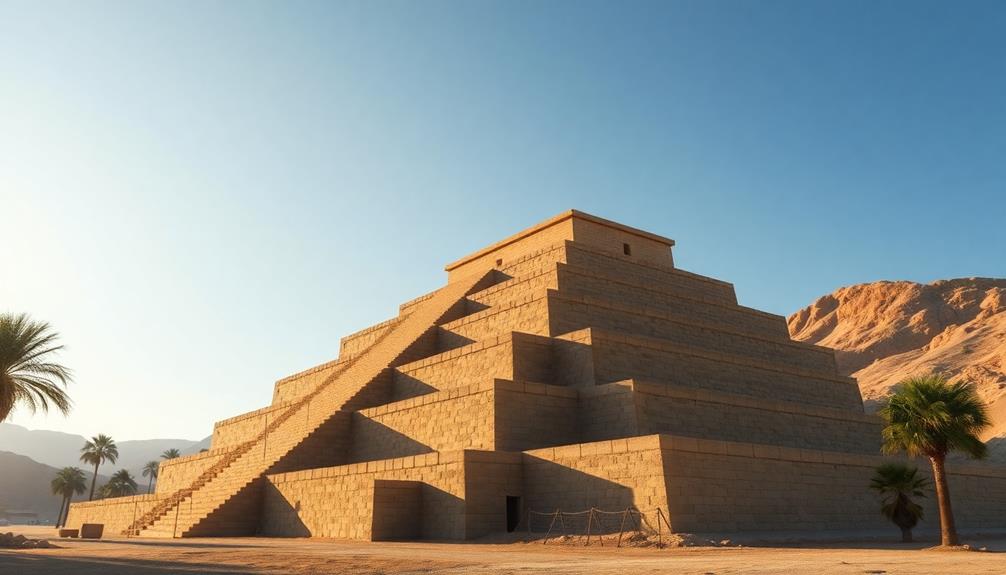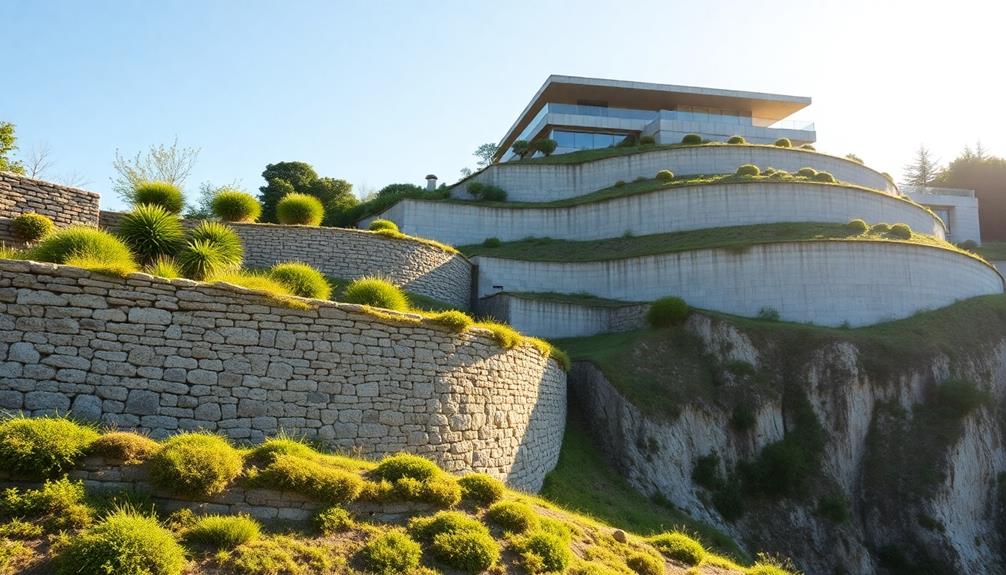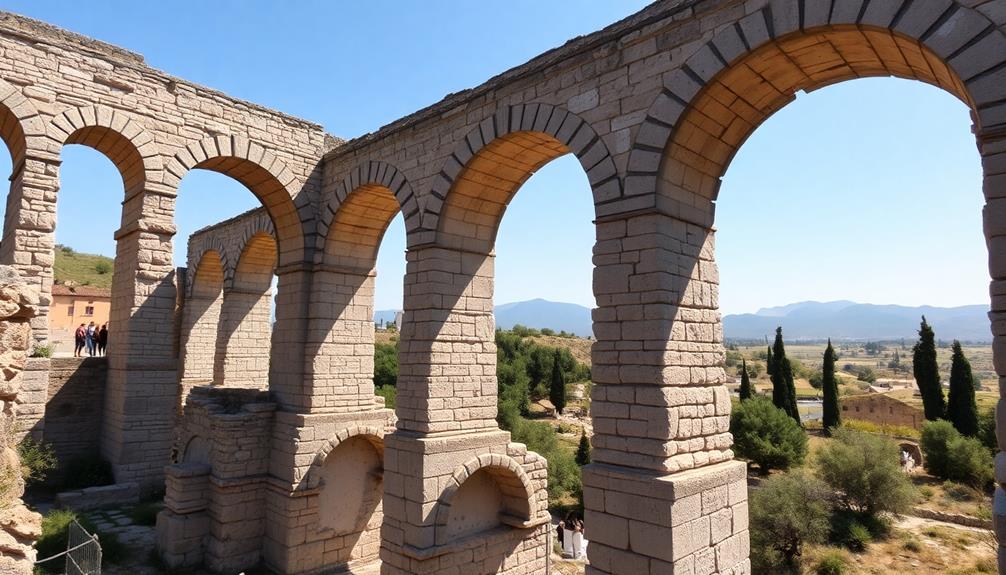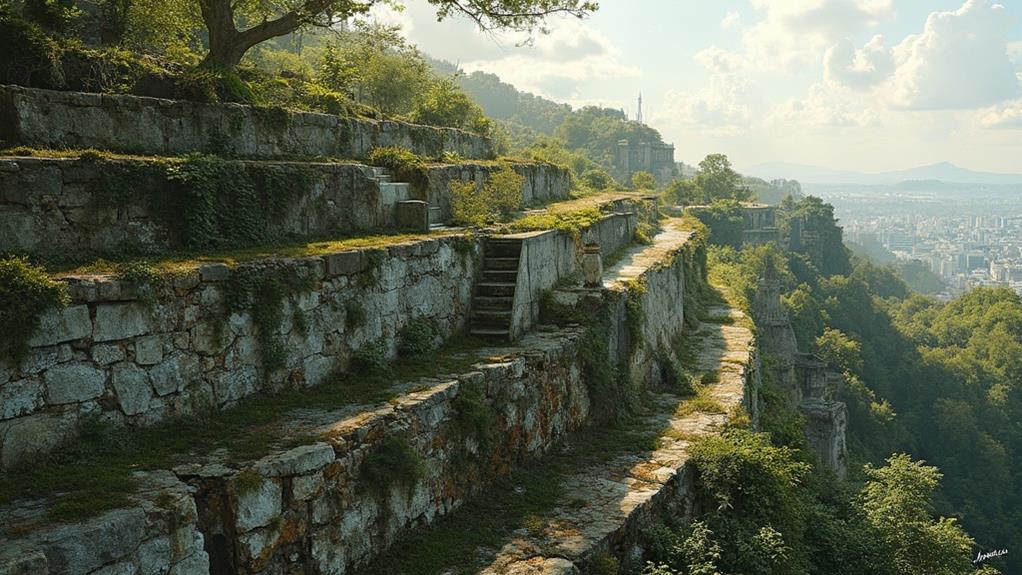Retaining walls, essential structures in civil engineering, have evolved considerably since ancient times. Their origins trace back to Mesopotamia, where sophisticated earth-retaining techniques were employed in ziggurats and the Hanging Gardens of Babylon. These early structures utilized innovative layering, drainage systems, and reinforcement methods to enhance stability and durability. The Fertile Crescent saw further advancements in flood control and agricultural applications. Roman innovations, particularly in concrete technology, revolutionized retaining wall construction, incorporating volcanic ash and hydraulic cement for increased strength and longevity. Throughout history, retaining walls have consistently provided erosion control, land transformation, and aesthetic enhancement. Their ongoing development continues to shape modern construction and landscape architecture.
Table of Contents
ToggleWalls Contractor Highlights
- Ancient Mesopotamian civilizations developed sophisticated earth-retaining structures like ziggurats with advanced layering and drainage techniques.
- Early ziggurat construction employed layered brickwork, stepped profiles, and complex drainage systems to ensure structural integrity.
- The Hanging Gardens of Babylon showcased advanced retaining wall techniques, including stone masonry and bitumen waterproofing.
- Fertile Crescent civilizations engineered flood control structures, influencing modern water management practices.
- Roman innovations in concrete technology, incorporating volcanic ash, significantly enhanced the durability and versatility of retaining walls.
Ancient Mesopotamian Earth-Retaining Structures

Ancient Mesopotamia, known as the cradle of civilization, witnessed the development of sophisticated earth-retaining structures that laid the foundation for modern engineering practices. The construction of ziggurats, massive stepped temples, employed advanced techniques to stabilize enormous earthen mounds, utilizing carefully layered materials and innovative drainage systems to prevent erosion and collapse.
These structures were built with a level of precision and craftsmanship that ensured all walls met what we might now recognize as code requirements, highlighting a tradition of structural integrity that persists today. These engineering principles were further refined in the creation of the legendary Hanging Gardens of Babylon, where elaborate terraces and supporting walls allowed for the cultivation of lush vegetation in an arid climate.
Similar earth-retaining methods were also applied throughout the Fertile Crescent to control flooding and manage water resources in this agriculturally rich region.
Early Ziggurat Construction Techniques
Among the earliest examples of large-scale earth-retaining structures, Mesopotamian ziggurats stand out as remarkable feats of ancient engineering. These monumental stepped pyramids, constructed primarily of sun-dried mud bricks, exemplify the ingenuity of early builders in managing immense earthen masses. The construction techniques employed in ziggurat building laid the foundation for future advancements in retaining wall technology.
Ziggurat builders utilized a sophisticated system of layered brickwork, with each successive level slightly smaller than the one below, creating a stable, stepped profile. This design inherently distributed the structure's weight, minimizing lateral earth pressures. Integral to the ziggurat's stability was the implementation of a complex drainage system. Clay pipes and bitumen-lined channels were strategically placed throughout the structure to divert water and prevent erosion.
The outer faces of ziggurats were often reinforced with fired bricks, providing additional durability against weathering. These early techniques demonstrate a profound understanding of soil mechanics and structural integrity, principles that continue to influence modern retaining wall design. The ziggurats' enduring presence serves as a legacy to the effectiveness of these ancient construction methods.
Babylonian Hanging Gardens Support
Innovation in ancient Mesopotamian earth-retaining structures reached new heights with the legendary Hanging Gardens of Babylon. These architectural marvels, believed to have been constructed around 600 BCE, required sophisticated engineering techniques to support multiple levels of lush vegetation in an arid climate.
The gardens' design likely incorporated a series of terraces, each supported by robust retaining walls capable of withstanding substantial soil pressure and water weight. Scholars theorize that the Babylonians employed a combination of stone masonry and bitumen waterproofing to create the garden's foundational structure.
The retaining walls, potentially constructed using stepped stone courses, would have been reinforced with lead sheeting to prevent water seepage. This innovative approach allowed for the creation of a complex irrigation system, distributing water from the nearby Euphrates River throughout the various levels of the gardens.
The walls not only retained soil but also facilitated the cultivation of diverse plant species, creating a verdant oasis in the heart of the ancient city. This remarkable feat of engineering demonstrates the Babylonians' advanced understanding of structural support systems and hydraulics, setting a precedent for future developments in retaining wall technology.
Fertile Crescent Flood Control
The Fertile Crescent, encompassing parts of modern-day Iraq, Syria, Lebanon, Jordan, Israel, Egypt, Turkey, and Iran, faced recurring challenges from devastating floods. To mitigate these threats, ancient Mesopotamian civilizations developed sophisticated earth-retaining structures that served as both flood control mechanisms and agricultural innovations. These early retaining walls, constructed primarily of mud-brick and stone, were instrumental in channeling and redirecting floodwaters from the Tigris and Euphrates rivers.
The Sumerians, Akkadians, and Babylonians engineered complex networks of levees, dikes, and canals that not only protected their settlements but also facilitated irrigation for their crops. These structures, some reaching heights of several meters, utilized techniques such as corbelling and reinforcement with reeds to enhance stability.
The implementation of these flood control measures allowed for the expansion of arable land and the establishment of permanent settlements in previously uninhabitable areas. As a result, the region experienced unprecedented agricultural productivity, supporting larger populations and fostering the growth of advanced societies. The legacy of these ancient earth-retaining structures continues to influence modern flood control and water management practices in the region.
Benefits

Retaining walls offer a multitude of benefits that extend beyond their primary function of holding back soil. These structures play a vital role in erosion control and prevention, while simultaneously increasing usable land area by transforming sloped terrain into level, functional spaces.
They also have a significant impact on preserving the structural integrity of properties, particularly in challenging landscapes such as shorelines. In addition, retaining walls provide structural support for soil, enhancing property aesthetics and potentially increasing property value through improved landscaping and stability.
Erosion Control and Prevention
Serving as a pivotal line of defense against soil erosion, retaining walls offer significant benefits in erosion control and prevention. These structures effectively manage the movement of soil, particularly in areas prone to natural displacement due to gravity, water runoff, or wind. By stabilizing slopes and hillsides, retaining walls create a barrier that holds soil in place, preventing the gradual loss of land that can occur over time.
The evolution of retaining wall design has led to increasingly sophisticated systems that not only halt erosion but also promote proper drainage. Modern retaining walls often incorporate permeable materials or drainage systems that allow water to flow through while retaining soil particles. This dual functionality addresses both surface erosion and subsurface water pressure, which can be equally detrimental to landscape integrity. Additionally, retaining walls can be strategically placed to redirect water flow, reducing the erosive force of runoff on vulnerable areas. By preserving the natural contours of the land and preventing soil loss, these structures play a pivotal role in maintaining the ecological balance of both natural and landscaped environments, ensuring the long-term stability of our surroundings.
Increased Usable Land Area
Beyond their role in erosion control, retaining walls offer a vital advantage in land utilization. By effectively managing slopes and elevations, these structures enable property owners to maximize the usable area of their land. In residential settings, retaining walls can transform steep, unusable hillsides into functional terraced gardens or expanded outdoor living spaces. This increased usability not only enhances the aesthetic appeal of a property but also adds tangible value to the real estate.
In urban environments, retaining walls play a fundamental role in optimizing limited space. They facilitate the construction of multi-level parking structures, sunken plazas, and tiered commercial developments. By creating level surfaces on otherwise challenging terrain, retaining walls allow for more efficient use of available land, particularly in densely populated areas where every square foot is valuable.
Additionally, in agricultural contexts, these structures enable the creation of arable land on hillsides through terracing, dramatically expanding food production capabilities. The ability to increase usable land area through retaining wall construction has profound implications for urban planning, agriculture, and sustainable development, making it an indispensable tool in the ongoing quest to balance human needs with environmental constraints.
Enhanced Property Aesthetics
A significant benefit of retaining walls lies in their potential to enhance property aesthetics. These structures, while primarily functional, have evolved to become integral elements of landscape design, seamlessly blending form with function. Retaining walls can transform mundane slopes into visually striking terraces, creating a sense of depth and dimension within a property's topography. By incorporating various materials such as natural stone, brick, or decorative concrete blocks, homeowners and landscape architects can craft walls that complement the existing architectural style of a residence or commercial building.
The versatility of retaining walls allows for the creation of distinct outdoor living spaces, elevating the overall appeal of a property. These structures can serve as backdrops for lush gardens, frame water features, or define outdoor entertainment areas. The interplay between the wall's texture, color, and surrounding vegetation adds visual interest and can noticeably boost curb appeal. Additionally, strategically placed retaining walls can direct attention to focal points within the landscape, guiding the eye and creating a cohesive, well-designed outdoor environment that enhances the property's value and aesthetic appeal.
Structural Support for Soil
While retaining walls can substantially enhance a property's visual appeal, their primary function remains rooted in engineering necessity. These structures serve as critical components in managing soil stability, particularly in areas with significant elevation changes or challenging topography. By providing robust structural support, retaining walls effectively counteract the lateral pressure exerted by soil masses, preventing erosion, landslides, and potential property damage.
The engineering principles behind retaining walls have evolved considerably over time, incorporating advanced materials and design techniques to maximize their effectiveness. Modern retaining walls utilize a combination of gravity, cantilever, and anchored systems to distribute forces and maintain soil integrity. These structures play a crucial role in urban development, infrastructure projects, and landscape architecture, allowing for the efficient use of space in both residential and commercial settings.
Early Roman Concrete Innovations

The Romans revolutionized construction with their innovative use of concrete, particularly in retaining wall structures. By incorporating volcanic ash into their concrete mix, they created a material that was not only stronger but also capable of setting underwater, leading to significant advancements in hydraulic cement technology. These early Roman innovations resulted in structures of unprecedented longevity, with many ancient retaining walls and harbors still standing today, testifying to the durability and effectiveness of their concrete formulations.
| Roman Concrete Innovation | Impact on Retaining Walls | Modern Significance |
|---|---|---|
| Volcanic Ash Addition | Increased Strength | Inspired Pozzolanic Cement |
| Hydraulic Cement | Underwater Construction | Enabled Marine Structures |
| Improved Formulations | Enhanced Durability | Long-lasting Infrastructure |
Volcanic Ash in Concrete
Roman engineers' groundbreaking discovery of volcanic ash as a key ingredient in concrete revolutionized the construction of retaining walls and other structures. This innovation, known as pozzolana, was sourced from the abundant volcanic deposits near Pozzuoli, Italy. When mixed with lime and water, it created a remarkably strong and durable concrete that could set underwater and resist the corrosive effects of seawater.
The incorporation of volcanic ash in concrete vitally enhanced the material's properties, allowing for the construction of more robust and long-lasting retaining walls. This advancement enabled Roman builders to create expansive harbors, aqueducts, and fortifications that have withstood the test of time. The pozzolanic reaction between the volcanic ash and lime produced a dense, impermeable matrix that contributed to the concrete's exceptional strength and durability.
This technological leap forward in construction materials facilitated the expansion of Roman infrastructure and played an indispensable role in the empire's ability to build and maintain its vast network of roads, bridges, and defensive structures. The legacy of this innovation continues to influence modern concrete technology, inspiring researchers to explore similar natural additives for enhancing contemporary building materials.
Hydraulic Cement Advancements
Building upon their success with volcanic ash, Roman engineers continued to refine their concrete formulations, leading to significant advancements in hydraulic cement. These innovations revolutionized construction practices, enabling the creation of more robust and durable retaining walls capable of withstanding immense pressures and environmental stresses.
The Romans discovered that by combining lime with specific types of volcanic ash, they could produce a cement that would harden underwater, a property known as hydraulicity. This breakthrough allowed for the construction of harbor structures, aqueducts, and coastal fortifications that were previously impossible. The resulting concrete exhibited remarkable strength and longevity, with many Roman structures still standing today, millennia after their construction.
Further experimentation led to the development of pozzolanic cements, which incorporated finely ground ceramic materials alongside volcanic ash. This formulation enhanced the concrete's resistance to chemical attacks and improved its overall durability. The Roman engineers' meticulous approach to material selection and mixing ratios resulted in a product that outperformed natural stone in many applications, setting a new standard for construction materials that would not be surpassed for centuries.
Longevity of Structures
Enduring for millennia, ancient Roman concrete structures stand as a testimony to the remarkable longevity achieved through early innovations in construction materials. The Romans' pioneering use of pozzolanic ash, combined with lime and volcanic rock, resulted in a concrete that not only withstood the test of time but also demonstrated self-healing properties.
This revolutionary mixture, known as opus caementicium, formed the foundation for many iconic structures that continue to captivate us today, such as the Pantheon and the Colosseum.
The exceptional durability of Roman concrete can be attributed to its unique chemical composition, which allows for the formation of mineral microstructures within the material over time. These structures, comprised of aluminum tobermorite and phillipsite, contribute to the concrete's ability to resist cracking and erosion, even in harsh marine environments.
Modern engineers and scientists continue to study these ancient techniques, seeking to replicate and improve upon the Romans' mastery of long-lasting construction materials. By understanding and implementing these time-tested principles, we can aspire to create structures that will stand as monuments to human ingenuity for generations to come.
Walls Contractor FAQ
How Do Modern Retaining Walls Differ From Their Historical Counterparts?
Modern retaining walls incorporate advanced materials and engineering techniques, offering superior strength and durability. They often feature improved drainage systems, eco-friendly designs, and aesthetic versatility. These enhancements allow for taller, more efficient structures that seamlessly blend with their surroundings.
What Are the Environmental Impacts of Different Retaining Wall Materials?
Different retaining wall materials have varying environmental impacts. Concrete production emits significant CO2, while timber may contribute to deforestation. Recycled materials and natural stone offer more sustainable options. Proper material selection can minimize ecological footprints and foster community environmental responsibility.
Can Retaining Walls Be Aesthetically Pleasing While Maintaining Structural Integrity?
Modern retaining walls can be both structurally sound and visually appealing. By incorporating natural materials, creative designs, and landscaping elements, we can create beautiful, functional walls that enhance our outdoor spaces while providing essential support.
Are There Any Notable Failures of Retaining Walls Throughout History?
Yes, notable retaining wall failures have occurred throughout history. These incidents remind us of the importance of proper design and maintenance. As a community of builders and engineers, we learn from these events to improve safety standards.
How Do Building Codes and Regulations Affect Retaining Wall Construction Today?
Building codes and regulations greatly impact retaining wall construction today. They guarantee safety, structural integrity, and environmental compliance. These guidelines dictate design standards, material requirements, and inspection processes, fostering a sense of security within our communities.







